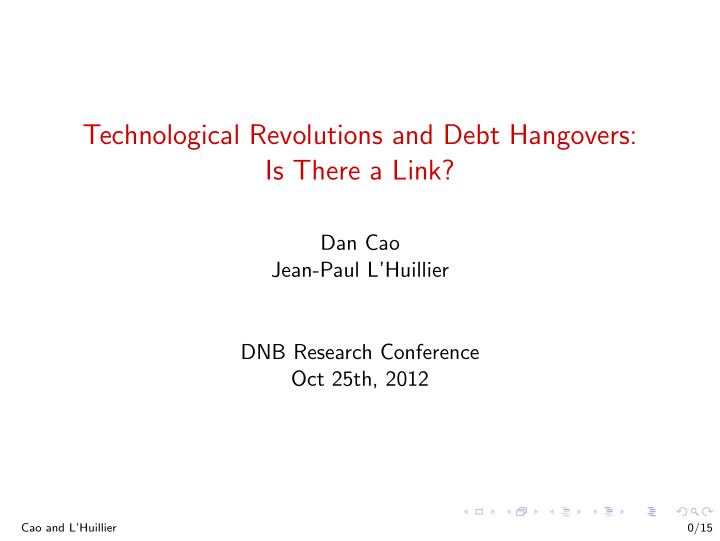



Technological Revolutions and Debt Hangovers: Is There a Link? Dan Cao Jean-Paul L’Huillier DNB Research Conference Oct 25th, 2012 Cao and L’Huillier 0/15
Introduction ◮ Observation: ◮ Before Great Recession: IT (late 1990s) ◮ Before Japanese crisis 1990s: electronics (1980s) ◮ Before Great Depression: combustion/electricity (1910-1925?) ◮ Write a business cycle model ◮ Anticipations about the future + imperfect information ◮ Main mechanism: Rational formation of beliefs around tech rev ◮ Focus: 1. Consumption 2. Medium frequencies Cao and L’Huillier 1/15
Model: Productivity ◮ Productivity sum of two components: a t = x t + z t ◮ permanent component ∆ x t = ρ ∆ x t − 1 + ε t ◮ transitory component z t = ρ z t − 1 + η t . Cao and L’Huillier 2/15
Information “News and Noise” information structure (Blanchard, L’Huillier & Lorenzoni) ◮ Agents observe: 1. current productivity a t 2. noisy signal regarding the permanent component x t s t = x t + ν t Plan : 1. Study Kalman filter of these agents 2. Put into open economy a la Aguiar & Gopinath (2007) 3. Do structural estimation for the 3 episodes Cao and L’Huillier 3/15
Key: Slow Adjustment of Beliefs Borrow idea from Hobijn & Jovanovic (1999): “Technological revolutions come in waves” 1. Start of tech rev Increase in growth of permanent productivity (from the old, deterministic, trend) 2. End of tech rev Decrease in growth of permanent productivity (from the new trend) ◮ Consumers use Kalman filter to update beliefs ◮ Try to track path of permanent component ◮ Slow to adjust beliefs after slowdown ◮ Remain “optimistic” for a while Cao and L’Huillier 4/15
An Example: Off-trend Permanent Tech Shocks Cao and L’Huillier 5/15
An Example: Off-trend Permanent Tech Shocks, cont. Cao and L’Huillier 5/15
Model ◮ Open economy DSGE ◮ Use previous information structure ◮ Permanent income consumers ◮ Form beliefs about the future path of x t ◮ These beliefs affect consumption and net exports Cao and L’Huillier 6/15
Consumers and Production ◮ Representative consumer maximizes � �� ∞ � ϕ 1+ φ N 1+ φ β t ∑ ln( C t ) − E t t t =0 subject to C t + B t − 1 = W t N t + Q t B t ◮ B t is external debt ◮ Linear production and competitive goods market Y t = e a t N t . Cao and L’Huillier 7/15
Resource Constraint and Interest Rate ◮ Resource constraint C t + NX t = Y t ◮ Interest rate 1 Bt = R t = R ∗ + ψ � � Yt − b − 1 e Q t ◮ b is steady-state level of B / Y ratio Cao and L’Huillier 8/15
IRFs to a Permanent Tech Shock ε t Debt accumulation comes with a delay Cao and L’Huillier 9/15
Parameter Estimates: IT Revolution (US 1990–2010) Data: labor productivity, and NIPA net exports (using consumption gives similar results) Parameter Description Value ρ Persistence tech. shocks 0.98 σ u Std. dev. productivity 0.63 Std. dev. permanent tech. shock 0.01 σ v σ z Std. dev. transitory tech. shock 0.62 σ s Std. dev. noise 10.80 Cao and L’Huillier 9/15
Estimated States Using Data on a t and nx t (U.S. 1990-2010) Smoothed and detrended long-run component of productivity ( x t + ∞ , in black ), and consumers’ contemporaneous beliefs ( E t [ x t + ∞ ], in blue ) Estimation suggests optimism came with a delay Cao and L’Huillier 10/15
Out-of-Sample Check: Comparison With Survey Evidence Cao and L’Huillier 11/15
Reason for delay: productivity-to-consumption ratio, US (1990–2010) ◮ IT Revolution: productivity boom in the 1990s ◮ Wavy-form: ◮ Declining productivity growth rates over the period: 1.87% for 1990:1–2005:1; 1.18% for 2005:2–2010:1 Cao and L’Huillier 12/15
Japan (1975–2003) ◮ Electronics Revolution: productivity boom in the 1980s ◮ Wavy-form (productivity-to-consumption ratio): ◮ Declining productivity growth rates over the period: 3.22% for 1975:1–1990:1; 1.06% for 1990:2–2003:1 Cao and L’Huillier 12/15
US (1919–1933) ◮ Combustion/Elec. Revolution: productivity boom in the 1920s ◮ Wavy-form (productivity-to-consumption ratio): ◮ Declining productivity growth rates over the period: 2.82% for 1920:1–1926:1; -.91% for 1926:2–1933:1 Cao and L’Huillier 12/15
Dynamics of Debt-to-Output Ratio Depends on three elements: 1. Persistence of permanent technology process: ρ (income effect + persistence of beliefs) 2. Relative size of standard deviations: σ v , σ z , σ s (speed of learning) 3. Timing of the shocks (degree of optimism before slowdown) Cao and L’Huillier 13/15
Dynamics of Debt-to-Output Ratio Implied by the Estimated Model In 2010: low productivity and high debt Cao and L’Huillier 14/15
Conclusions ◮ Contribution to literature on tech rev ◮ Investigate implications for the cycle ◮ Point out: tech rev precede private debt crisis ◮ Attempt to understand why ◮ Slow adjustment of beliefs seems key ◮ Analyze implications for debt dynamics after 2010 ◮ High levels of debt + productivity slowdown = ⇒ Long, debt related, consumption slump Cao and L’Huillier 15/15
Recommend
More recommend